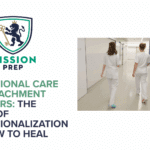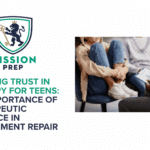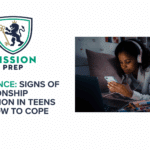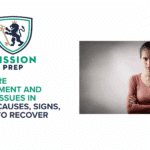Reactive Attachment Disorder in Teens: Causes, Signs, & Support

As a parent, it can be heartbreaking to see your teen push people away or battle with emotions they can’t explain. If your child has a history of early trauma, neglect, or inconsistent caregiving, their struggles may be a sign of reactive attachment disorder in teens.
Although it’s a condition that typically develops in early childhood, reactive attachment disorder (RAD) teens can still carry invisible wounds that affect how they trust, connect, and cope. For instance, RAD may make your teen seem angry or withdrawn – but under the surface, pain and fear are fuelling their behavior.
The good news is that with understanding and professional support, teens with RAD can start to heal. If you’re concerned that your teen shows signs of reactive attachment disorder, we’re here to support you.
This page can also help, as it covers the ins and outs of…
- What reactive attachment disorder is
- Signs and symptoms of RAD to watch for
- Potential causes of RAD
- How attachment disorder affects a teen
- Treatment options available for RAD
- Where to find professional support

What Is Reactive Attachment Disorder?
RAD in Children
Children with RAD usually avoid interacting with others if possible, and, if they do, may show very few emotions. For instance, when distressed, children with RAD may not seek out comfort and find it difficult to calm down, even when their caregiver tries to soothe them. In fact, they can become even more sad or scared around their caregivers than with other people.1 The behavior of children with RAD is often unpredictable, and changes to routines can be extremely distressing.2RAD in Teens
Reactive behavior in teens may show itself in more complex ways than in children. Teenagers with RAD may be withdrawn or distant, struggle to form close connections with people, and push people away. They could also become aggressive, argumentative, or defiant. However, often underlying such behaviors is a deep fear of abandonment or rejection. Based on such difficulties with social skills, like forming stable relationships and regulating emotions, RAD is sometimes considered to be an emotional detachment disorder. Early intervention is key when it comes to treating attachment disorders. However, it’s still possible to recover at any stage of life. With professional support, teens can learn to manage their emotions in healthy ways and create meaningful connections with others.RAD vs Other Attachment Styles
To understand the difference between attachment styles and attachment disorders, it can help to consider the background of attachment theory.
Attachment Theory and Styles
Attachment theory was developed by John Bowlby, a psychologist and psychoanalyst, in the 1950s. The theory describes the way that attachments are made with caregivers during childhood, and the impact this bond can have on people as they develop.3
The first three attachment styles came from a research experiment, called the “Strange Situation,” which was carried out by Mary Ainsworth. These styles were secure, insecure-anxious, and insecure-avoidant. A colleague of Ainsworth’s, Mary Main, later noticed a pattern of behavior in certain children that didn’t fit within the previous categories and identified insecure-disorganized attachment.
Each of these styles develops from how needs were met during formative years and reflects patterns of how we relate to other people.4 For example, secure attachment tends to result from needs being met consistently and accurately, leading to trust in others and healthy self-esteem. In contrast, the insecure attachment style can stem from inconsistent, rejecting, or chaotic caregiving, often creating fears of abandonment and rejection, as well as self-worth issues.
However, it’s good to know that attachment is a spectrum, and children, teens, and adults can shift between styles based on their experiences and circumstances.
Attachment Disorders
Two different attachment disorders can evolve in children if healthy attachments are disrupted during their early years. These are RAD and disinhibited social engagement disorder (DSED).
RAD and DSED could be seen as two different responses to the same situation. Both conditions are caused by trauma, neglect, and early attachment problems, but each disorder presents itself very differently.
In RAD, children are less likely to look to others for comfort when they feel distressed, even their parents or caregivers. They typically find it difficult to have emotional attachments to people and can seem withdrawn and avoidant.5,6
In DSED, however, children and teens can be overly friendly with people, trusting strangers as much as they trust their own parents. They may be overly chatty, ask personal questions, and even walk off with unknown adults without thinking about danger. In other words, children with DSED may not be selective about who they seek comfort from.
RAD Symptoms in Adolescents
If you’re worried about your teen and think they may have an attachment disorder, know that you’re not alone. Although it is a rare disorder (affecting roughly 1-2% of people), the signs of RAD in teenagers can help you determine whether your child could benefit from professional help.2
The symptoms of RAD may vary depending on how severe the disorder is, but some of the more common symptoms include:7,8
- Fear
- Sadness
- Anger
- Lack of empathy
- Difficulty forming emotional connections with parents or caregivers
- Withdrawal from people and interactions
- Poor social skills
- Control issues
- Academic problems
- Avoidance of physical contact
- Risk-taking behaviors
- Memory problems or poor problem-solving skills
Without treatment, the signs of RAD may worsen or continue into adulthood, impacting many areas of life. However, understanding the causes of RAD and how it affects life can help foster compassion – increasing the likelihood that a teen will be open to support.
Causes of RAD in Youth
RAD develops when a child is unable to form healthy emotional bonds or attachments with their primary caregivers (usually their parents). This might be due to neglect, abuse, trauma, or inconsistent caregiving.
There is a strong link between trauma and RAD, as issues such as emotional neglect can contribute to attachment disorders. This effect can be seen in homes with severely mentally or physically ill parents. Additionally, attachment issues in foster youth are relatively common, as frequent transitions can limit the chance to create secure bonds with a caregiver.7 In fact, evidence suggests that 42% of children who are placed in settings other than the home meet the criteria for behavioral health disorders such as RAD.2
This information isn’t to suggest that people who care for children in these settings aren’t doing their best. It’s just that time and attention are often limited resources, meaning that children sometimes don’t receive the emotional attention they need.
It’s not just in orphanages and foster homes that RAD and early neglect can occur. RAD can develop if there is:2,7
- Neglect of emotional needs
- A constant change of caregivers
- An unstable or dangerous home environment
- Early traumatic experiences
- Abuse
- Separation from parents
If you have an adopted child who is showing signs of RAD, this may be due to their early environment. Despite your best efforts, RAD can be difficult to overcome alone. However, increased awareness can mean you can feel better equipped to support your teen in overcoming this disorder.
Professional support for an attachment disorder can help your teen develop a better attitude toward themselves and create healthier relationships with others. However, before we discuss treatment options, let’s look at the impact RAD can have on a teen.
Challenges Teens With RAD Face
RAD can have a significant impact on a teen’s mental well-being, affecting many areas of life, from school and learning to their sense of self.
The following information takes a closer look at the challenges teens with RAD face.
Personal Life and Emotional Issues
RAD can cause intense mood fluctuations, including a tendency to react aggressively toward potential stressors or changes in routine. The trauma the teenager previously experienced essentially causes them to live in the “fight, flight, or freeze” mode. This means they exist in a state of near-constant stress or fear.
Attempts to manage intense emotions can lead to teen emotional withdrawal. This might look like dissociation or avoiding others due to fears of rejection or abandonment. Teens with RAD may appear independent, wanting to control their space and make their own decisions. They’re also more likely to have a negative self-view and have an increased risk of mental health conditions such as anxiety, depression, and anger management issues.2,8
Academic Challenges
The aggressive behaviors and mood swings that teens with RAD are typically prone to can lead to problems at school. For instance, they may be overly controlling when it comes to work, or argumentative with teachers and peers, leading to disruptions in the classroom.7 Additionally, childhood abuse has been linked with difficulties in memory and executive functioning, putting further strain on academic abilities.2
Relationship Difficulties
Teens with RAD can struggle to form emotional attachments to others, whether friendships, romantic relationships, or family connections. Such youth trust and attachment issues can manifest as withdrawing from intimacy and comfort and poor social and emotional skills.2 Additionally, impulsive reactions mean teens with RAD may be more likely to engage in risky behavior, including sexual intercourse, and could find themselves at odds with the law.7
Parenting teens with RAD can feel like an uphill struggle, but there is hope. Treatment and support are available to help your teen develop a healthier attitude toward themselves and others.
Treatment for RAD in Teens
If you believe your teen may have reactive attachment disorder, there are treatments available to help manage their symptoms and allow them to build healthier attachments.
Although there is no “gold standard” treatment for RAD, there are effective options that can manage the condition. These often take a multi-faceted approach, involving both the teen and caregivers to enable healing to take place. Treatments include talking therapy, family therapy, and education.2,9 We discuss each of these options in more detail below.
Therapy for RAD in Youth
Talking therapy can be very beneficial for teens struggling with RAD. Therapy allows teenagers to process their trauma in a safe, supportive space with a mental health professional. They can discuss issues or concerns they may have, learn about their condition, unpick unhelpful thinking or behavior patterns, and learn how to trust and build healthy, secure relationships. As RAD can form from early childhood traumatic experiences, trauma-focused therapy may be particularly useful.2
Family Therapy
Therapy involving both the parent and teen can be effective in strengthening emotional bonds and building healthy attachment. It provides the opportunity to create a more nurturing connection between parent and child, without judgment, blame, or stigma.
Parental Education
Learning about your child’s condition can be one of the most impactful steps toward positive change. Understanding where RAD comes from, as well as how to help a teen heal and move forward, is a great way to support their development.

Mission Prep: Professional Support for Teens with RAD
The signs of reactive attachment disorder can feel emotionally challenging – for both teens and their caregivers. Early intervention is the key to healing, but it’s never too late to start working toward healthier bonds and templates for relationships. With the right support, your teen can learn how to thrive emotionally and socially.
If you are concerned your teen may have RAD, know that you’re not alone. At Mission Prep, our team of licensed mental health professionals specializes in treating teens with attachment disorders and can guide you through recovery every step of the way.
If the time to seek help has arrived, you can call or contact our team via our secure online form to find out how we can help your teen heal and create a positive, lasting change.
References
- American Academy of Child & Adolescent Psychiatry (AACAP). (2017). Attachment disorders. https://www.aacap.org/AACAP/Families_and_Youth/Facts_for_Families/FFF-Guide/Attachment-Disorders-085.aspx
- Ellis, E. E., Yilanli, M., & Saadabadi, A. (2023, May 1). Reactive attachment disorder. StatPearls – NCBI Bookshelf. https://www.ncbi.nlm.nih.gov/books/NBK537155/
- McGarvie, S., PhD. (2025, March 27). Attachment Theory, Bowlby’s Stages & Attachment Styles. PositivePsychology.com. https://positivepsychology.com/attachment-theory/
- Ainsworth, M. D. S., & Bell, S. M. (1970). Attachment, exploration, and separation: Illustrated by the behavior of one-year-olds in a strange situation. Child Development, 41(1), 49–67. https://doi.org/10.2307/1127388
- WebMD. (2023, May 20). What is Disinhibited Social Engagement Disorder? https://www.webmd.com/children/what-is-disinhibited-social-engagement-disorder
- Marie, S. (2021, September 29). Symptoms of Disinhibited Social Engagement Disorder (DSED). Psych Central. https://psychcentral.com/disorders/symptoms-of-disinhibited-social-engagement-disorder
- Attachment and Trauma Network, ATN. (2023, October 13). Reactive Attachment Disorder (RAD). https://www.attachmenttraumanetwork.org/reactive-attachment-disorder-rad/
- Kandola, A. (2020, November 2). What is reactive attachment disorder? Medical News Today. https://www.medicalnewstoday.com/articles/reactive-attachment-disorder
- Mayo Clinic. (2022, May 12). Reactive attachment disorder. https://www.mayoclinic.org/diseases-conditions/reactive-attachment-disorder/diagnosis-treatment/drc-20352945



















